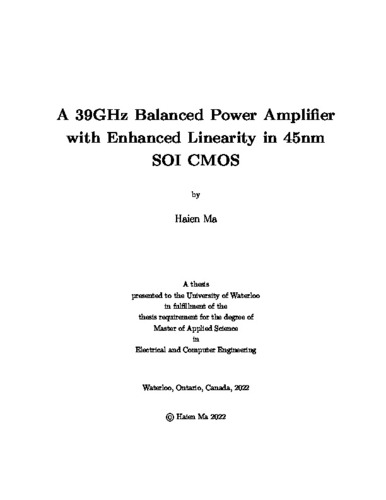| dc.contributor.author | Ma, Haien | |
| dc.date.accessioned | 2022-09-20 15:00:50 (GMT) | |
| dc.date.available | 2022-09-20 15:00:50 (GMT) | |
| dc.date.issued | 2022-09-20 | |
| dc.date.submitted | 2022-09-08 | |
| dc.identifier.uri | http://hdl.handle.net/10012/18758 | |
| dc.description.abstract | With the high data rate communication systems that come with fifth-generation (5G) mobile networks, the shift of operation to millimeter-wave frequency becomes inevitable. The expected data rate in 5G is significantly improved over 4G by utilizing the large available channel bandwidth at millimeter wave frequencies and complex data modulation schemes. With this increase in operation frequency, many new challenges arise and research efforts are made to tackle them. Among them, the phased array system is one of the hottest topics as it can be made use of to improve the link budget and overcome the path loss challenge at these frequencies.
As the last circuit component in the transmitter's front-end right before the antenna, the power amplifier (PA) is one of the most crucial components with significant effects on overall system performance. Many of the traditional challenges of CMOS PA design such as output power and efficiency, are now compounded with the additional challenges that are imposed on complementary metal-oxide semiconductor (CMOS) PAs in millimeter wave phased array systems.
This thesis presents a balanced power amplifier design with enhanced linearity in GlobalFoundries' 45nm silicon-on-insulator (SOI) CMOS technology. By using the balanced topology with each stage terminating with a differential 2-stacked architecture, the PA achieves saturated output power of over 21 dBm. Each of the two identical sub-PAs in the balanced topology uses 2-stage topology with driver and PA co-design method. The linearity is enhanced through careful choice of biasing point and a strategic inter-stage matching network design methodology, resulting in amplitude-to-phase distortion below 1 degree up to the output 1dB compression level of over 19 dBm. The balanced amplifier topology significantly reduces the PA performance variation over mismatched load impedance at the output, thus improving the PA performance over different antenna active impedance caused by varying phased array beam-steering angles. In addition to this, the balanced topology also optimizes the PA input and output return loss, giving a better matching than -20 dB at both input and output, and minimizing the risk of potential issues and performance degradation in the system integration phase. Lastly, the compact transformer based matching networks and quadrature hybrids reduce the chip area occupation of this PA, resulting in a compact design with competitive performance. | en |
| dc.language.iso | en | en |
| dc.publisher | University of Waterloo | en |
| dc.subject | 5G | en |
| dc.subject | Power Amplifier | en |
| dc.subject | Phased Array | en |
| dc.title | A 39GHz Balanced Power Amplifier with Enhanced Linearity in 45 nm SOI CMOS | en |
| dc.type | Master Thesis | en |
| dc.pending | false | |
| uws-etd.degree.department | Electrical and Computer Engineering | en |
| uws-etd.degree.discipline | Electrical and Computer Engineering | en |
| uws-etd.degree.grantor | University of Waterloo | en |
| uws-etd.degree | Master of Applied Science | en |
| uws-etd.embargo.terms | 0 | en |
| uws.contributor.advisor | Boumaiza, Slim | |
| uws.contributor.affiliation1 | Faculty of Engineering | en |
| uws.published.city | Waterloo | en |
| uws.published.country | Canada | en |
| uws.published.province | Ontario | en |
| uws.typeOfResource | Text | en |
| uws.peerReviewStatus | Unreviewed | en |
| uws.scholarLevel | Graduate | en |

